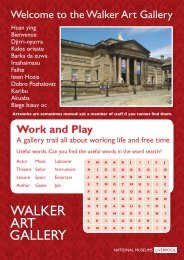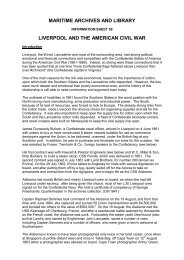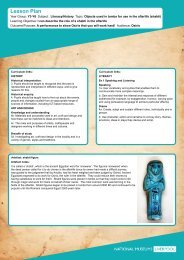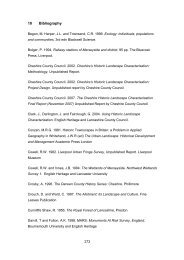Dealers and collectors - National Museums Liverpool
Dealers and collectors - National Museums Liverpool
Dealers and collectors - National Museums Liverpool
Create successful ePaper yourself
Turn your PDF publications into a flip-book with our unique Google optimized e-Paper software.
Literature· B. Webber, James Orrock, R.I.: painter, connoisseur, collector, 2 vols. (1903)· Edward Morris, ‘James Orrock, dentist, artist, patron, collector, dealer, curator,connoisseur, forger, propag<strong>and</strong>ist'. Visual Culture in Britain, 6:2 (2005), pp.8498.Duveen BrothersArt dealers. Founded by Henry Duveen (18541919) <strong>and</strong> his brother, Joseph Joel (18431908), in 1871, in Oxford Street London, they were initially dealers in furniture <strong>and</strong> objects ofvirtu. The family were originally from Meppel in Holl<strong>and</strong> <strong>and</strong> were sent to Engl<strong>and</strong> by theirmother to sell Delftware. The two brothers were so successful that they opened a new shop at21 Old Bond Street <strong>and</strong> Henry established premises in New York, winning clients such asJohn Pierpont Morgan, Benjamin Altman <strong>and</strong> Henry Clay Frick. Both Henry <strong>and</strong> Joseph Joelwere dealers in Chinese porcelains. Joseph Joel’s son Joseph (18691939) joined the firm in1887, becoming President of the firm (190939), <strong>and</strong> being raised to the Peerage as LordDuveen of Millbank. He was the most flamboyant <strong>and</strong> successful member of the family <strong>and</strong>dealt mostly in Old Master paintings.Literature· Meryle Secrest, Duveen: a life in art, New York 2004.· S N Behrman, Duveen, London 1952;· James Henry Duveen, Collections <strong>and</strong> Recollections. A century <strong>and</strong> a half of artdeals, London 1935.James Henry DuveenArt dealer <strong>and</strong> author. James Henry Duveen (b.1873), known as Jack, or Jacques, was thecousin of Joseph Duveen (Lord Duveen of Millbank). He ran the family’s <strong>Liverpool</strong> gallerybefore moving to 38 Dover Street in London in 1906 <strong>and</strong> then to 9 Old Bond Street in 1908.He initiated a lawsuit for sl<strong>and</strong>er against his cousin Joseph in 1910, when the latter tried to
compromise a number of sales to clients Sir William Bennett <strong>and</strong> William Lever. James Henrywas author of Collections <strong>and</strong> Recollections. A century <strong>and</strong> a half of art deals, London 1935.Literature· Meryle Secrest, Duveen: a life in art, New York 2004.Edgar GorerArt dealer. S. Gorer & Son was founded by Solomon Lewis Gorer (18401907), <strong>and</strong> hadpremises at 170 New Bond Street, London. The company's agent in New York was thejeweller Dreicer & Co., at 560 Fifth Avenue. It was in the h<strong>and</strong>s of Solomon's son, EdgarEzekiel Gorer (18721915), that 'Gorer', as it became known, became an international dealerin Chinese art, particularly Chinese ceramics, boasting major clients in Britain <strong>and</strong> across theAtlantic. Edgar Gorer was ambitious <strong>and</strong> gained a reputation for buying up importantcollections, such as that formed by Richard Bennett, Sir William Bennett, George R. Davies<strong>and</strong> Alfred Trapnell, <strong>and</strong> promoting them through exhibition <strong>and</strong> privately printed catalogues,often with colour plates. Gerald Reitlinger, in his 'Economics of Taste', aptly described Goreras being 'the meteoric rival of the Duveens'. He entered into two lawsuits as a result of hishigh profile activities, one with William Hesketh Lever over the purchase of the RichardBennett Collection <strong>and</strong> Duveen over a Kangxi vase, which Gorer had offered to Frick butwhich Duveen had claimed was a fake. The latter lawsuit was never heard in court. On theday of its announcement, 7th May 1915, Gorer was crossing the Atlantic on the Lusitaniawhich was torpedoed <strong>and</strong> he lost his life. He was 43. Edgar Gorer married Rachel AliceCohen (18731954) in 1902 <strong>and</strong> lived in some elegance at 45 Netherhall Gardens in SouthHampstead. Their three sons were the writer <strong>and</strong> social anthropologist, Geoffrey Gorer,geneticist, Peter Gorer <strong>and</strong> the horticulturalist, Richard Gorer.Edgar Gorer's publications include: (with J.F. Blacker),'Chinese Porcelain <strong>and</strong> Hardstones', 2volumes, London 1911 (this was a limited edition of 1000) <strong>and</strong> catalogues of exhibitions ofcollections including Alfred Trapnell (S. Gorer, 1906), Sir William Henry Bennett (Edgar Gorer& Sir William Henry Bennett, 1910), Richard Bennett (Edgar Gorer, 1911) <strong>and</strong> George R.Davies (G.R. Davies <strong>and</strong> Gorer, 1913). He also published 'A catalogue of rare specimens ofMing <strong>and</strong> early KangHe porcelain' (S. Gorer, 1907) <strong>and</strong> 'Old Chinese Porcelain', (EdgarGorer, 1910).Literature· Christian Jorg, 'Chinese Ceramics in the Collection of the Rijksmuseum Amsterdam:The Ming <strong>and</strong> Qing Dynasties', Amsterdam 1997, pp.16, 19.· Oliver Impey, Lever as a Collector of Chinese Porcelain, in 'Art <strong>and</strong> Business inEdwardian Engl<strong>and</strong>: The Making of the Lady Lever Art Gallery', Journal of the Historyof Collections, vol.4, no.2, 1992, pp.227238.· Gerald Reitlinger, 'The Economics of Taste: The rise <strong>and</strong> fall of objets d’art pricessince 1750, London 1963', vol.2, pp.213215.· Website: www.rmslusitania.info.· Jeremy MacClancy, 'Geoffrey Gorer (190585)', Dictionary of <strong>National</strong> Biography,2004.
<strong>and</strong> most respected London dealers in Chinese art.Literature· Times, 6 November 1934, p.19.· Archive location: SOAS Library, School of Oriental <strong>and</strong> African Studies, University ofLondon.Richard BennettRichard Bennett (b. 1849) was from Horwich, near Bolton, in Lancashire. Despite being amajor collector of books <strong>and</strong> manuscripts, as well as Chinese porcelain, Bennett is somewhatan obscure figure. By 1881 he was living at Great Lever Hall <strong>and</strong> was owner or manager ofJohn Smith Junior & Co., a bleaching <strong>and</strong> chemical manufacturing company in Great Lever.During 1890/91, Bennett moved to Southport <strong>and</strong> then to Manchester <strong>and</strong> by 1902 he wasliving at Thornby Hall in Northamptonshire, his residence when, in 1911, his collection wassold to William Hesketh Lever by Gorer for £275,000.Literature· Gorer, Edgar, ‘Catalogue of the Collection of old Chinese Porcelains formed by RichardBennett, Esq. Thornby Hall, Northampton’, London, 1911.· Impey, Oliver, ‘Lever as a collector of Chinese porcelain’ in Morris, Edward (ed.), “Art <strong>and</strong>Business in Edwardian Engl<strong>and</strong>: The Making of The Lady Lever Art Gallery”, Journal ofthe History of Collections, volume 4, number 2, 1992, p.234.Sir William BennettSir William Henry Bennett, KCVO (1852 1931), was an eminent surgeon, of 3 Hyde ParkPlace, London. He was elected Fellow of several learned societies (RCS Engl<strong>and</strong>, RoyalSociety of Medicine, the Zoological <strong>and</strong> Horticultural Societies). He published on surgicalsubjects <strong>and</strong> his appointments included Examiner in Surgery at Cambridge University,
Lecturer on Anatomy <strong>and</strong> Surgery at St George’s Hospital, <strong>and</strong> SurgeoninChief for St John’sAmbulance Brigade. For his services to sick & wounded of Boer War, he was made a KCVOin 1901.He collected paintings, furniture, Chinese porcelain (from Duveen, 19051906) & bronzes.The major part of his Chinese collections was sold in 1906. Gorer is said to have beeninstrumental in taking the best of this collection to the U.S. where it formed the nucleus ofsome of the finest American collections.Literature· Metropolitan Museum of Art, Duveen Client Summary Books 18941918 (copy at theGetty Research Institute)· American Art Association, Sir William Bennett, ‘Distinguished Paintings…Rare Bronzes,etc’, Sale no.5971, Friday 29 & Sat 30 April 1932, by order of Lady Bennett, AndersonGalleries, 30 East 57th Street, New York. Lots 77125 are Chinese works of art.· Gorer, Edgar, ‘A collection of rare old Chinese porcelains collected by Sir WilliamBennett, K.C.V.O’. Purchased & exhibited by Gorer, London, MayJune 1910.· ‘Who Was Who’, Vol 3, 192940, pp.9596.Sir Trevor LawrenceSir (James John) Trevor Lawrence, the son of Sir William Lawrence (17831867), SerjeantSurgeon to Queen Victoria <strong>and</strong> Louisa Lawrence (180355), a renowned orchid grower, SirTrevor (18311913) was himself trained as a surgeon, before becoming an MP <strong>and</strong> eventuallyPresident of the Royal Horticultural Society. He was a wellknown collector of objets d'art,particularly oriental, <strong>and</strong> especially Japanese art, western porcelain <strong>and</strong> old lace.Literature· Marcus B. Huish, Catalogue of the Collection of Japanese Works of Art formedbetween 1869 <strong>and</strong> 1894 by Sir Trevor Lawrence, Privately Printed, London, 1895.· Sale, Christie’s, 29 May – 1 June 1916, 'The collection of porcelain objects of art <strong>and</strong>decorative furniture of the late Sir Trevor Lawrence, BART'.
S. E. KennedySydney Ernest Kennedy (18551933), collected European works of art as well as Chineseporcelain. He was a senior partner in the family firm of Sydney Kennedy & Co., one of thelargest dealers in the foreign railway market <strong>and</strong>, at his death, was a senior trustee of theLondon Stock Exchange, having been elected a trustee in 1900. He lived at 146 GloucesterTerrace, Hyde Park (noted in the Christie’s 1929 Cumberbatch catalogue as a bidder) <strong>and</strong> athis death at Upper Brooke Street.Kennedy sold most of his collection when he disposed of his town house in 1916. TheChinese porcelains were sold over two days, 2122 June, 1916 <strong>and</strong> the Catalogue wasdescribed as being 'innovative', it including illustrations, some in colour, for the first time.Although consisting largely of late Ming <strong>and</strong> Kangxi period wares, the collection wasconsidered significant at the time, some having been acquired form earlier notable <strong>collectors</strong>,such as Trapnell, Stuart, Gr<strong>and</strong>idier, Huth <strong>and</strong> Revelstoke. Kennedy's label is recognised bya dolphin & SEK monogram on paper.William Hesketh Lever bought a series of fahua pieces from the 1916 sale, through FrankPartridge.Literature· The Times, Obituary, 'Mr S E Kennedy Senior Trustee of the Stock Exchange', 11July 1933, p.16.· Sale, Christie’s, 2122 June 1916, 'The wellknown collection of Chinese Porcelainformed by Sidney Ernest Kennedy, Esq'.· Gerald Reitlinger, 'The Economics of Taste, Vol II, The rise <strong>and</strong> fall of objets d’artprices since 1750', London 1963, p.313, 328.· Oliver Impey, 'Lever as a collector of Chinese porcelain', in 'Art <strong>and</strong> Business inEdwardian Engl<strong>and</strong>: The Making of the Lady Lever Art Gallery', Journal of the Historyof Collections, Vol.4, No.2, 1992, p.234.
C S HolbertonThis is probably Campbell Scott Holberton (18671939), a London Stockbroker <strong>and</strong> memberof the Arts Club. He lived at 15 Talbot Square, Hyde Park, London <strong>and</strong> lent his collection ofsnuff bottles to the 1913 Manchester Exhibition of Chinese Applied Art. William Hesketh Leverbought 155 pieces from the 1918 sale, through Frank Partridge.Literature· The Times, ‘Obituaries’, 2 nd November, 1939, p.1.· City of Manchester Art Gallery, ‘Catalogue of an Exhibition of Chinese Applied Art,Bronzes, Pottery, Porcelains, Jades, Embroideries, Carpets, Enamels, Lacquer, etc’,Manchester, 1913.· Christie, Manson & Woods, 26 June 1918, Catalogue of the collection of Chinesesnuff bottles formed by C. S. Holberton, Esq.R H BensonRobert Henry Benson (18501929), senior partner of Robert Benson & Co., Ltd., merchantbankers, London, was a Trustee of the <strong>National</strong> Gallery from 1912 <strong>and</strong> a collector ofpaintings, mostly early Italian, early Chinese porcelain, <strong>and</strong> other works of art. His propertiesincluded Walpole House, Chiswick Mall, W4, though by 1924 he was living at 16 South Street,Park Lane. His country house was Buckhurst Park, Withyham, Sussex.He married Evelyn Holford (18571943) in 1887 <strong>and</strong> who was herself a collector of Chineseporcelain <strong>and</strong> was joint owner of the Benson collection of Renaissance paintings, sold toJoseph Duveen in 1927 for US$2.5 million <strong>and</strong> dispersed to <strong>collectors</strong> such as Kress, Frick<strong>and</strong> Rockefeller.
Robert Benson was a member of the Burlington Fine Arts Club <strong>and</strong> lent generously to publicmuseums, for instance to the City of Manchester Art Gallery 'Exhibition of Chinese AppliedArt', 1913, to the V&A prior to his major Chinese ceramics sale in 1924, <strong>and</strong> the BensonCollection of paintings loaned to Manchester in 1927, which was subsequently purchased byDuveen. The 1924 Christie’s sale catalogue, for which much of the information came from thecollector, has been cited by Oliver Impey (1992 p.231) as the first learned auction housecatalogue. The Christie's catalogue refers to a private catalogue produced by Rackham forR.H. Benson some years ago.Literature· Christie, Manson & Woods, 1 July 1924, Catalogue of a portion of the collection of earlyChinese porcelain <strong>and</strong> pottery formed by Robert H. Benson, Esq, now the property ofMajor Rex Benson, Guy Benson Esq. <strong>and</strong> Con Benson Esq.· Reitlinger, Gerald, ‘The Economics of Taste’ 2 volumes, London 1963, volume 2, p.252refers to record prices made at the 1924 Christie’s sale.· ‘Who Was Who’, Vol 3, 192940, 1967 p.97.· Oliver Impey, 'Lever as a collector of Chinese porcelain', in 'Art <strong>and</strong> Business inEdwardian Engl<strong>and</strong>: The Making of the Lady Lever Art Gallery', Journal of the History ofCollections, Vol.4, No.2, 1992, pp.227238.· The Times, Obituary, April 8 1929, p.14.


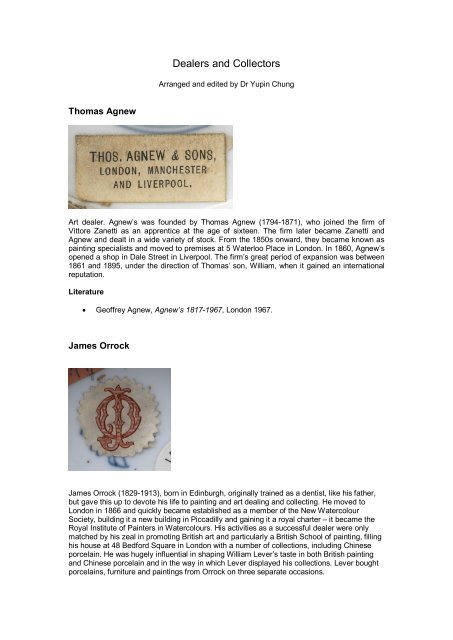
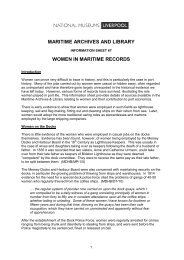
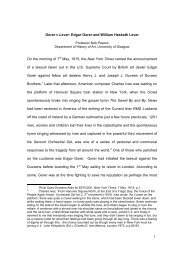
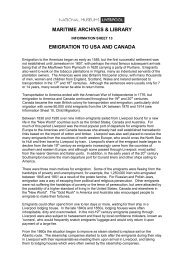
![Ancient Egypt trail [227kb .pdf] - National Museums Liverpool](https://img.yumpu.com/48998817/1/184x260/ancient-egypt-trail-227kb-pdf-national-museums-liverpool.jpg?quality=85)

